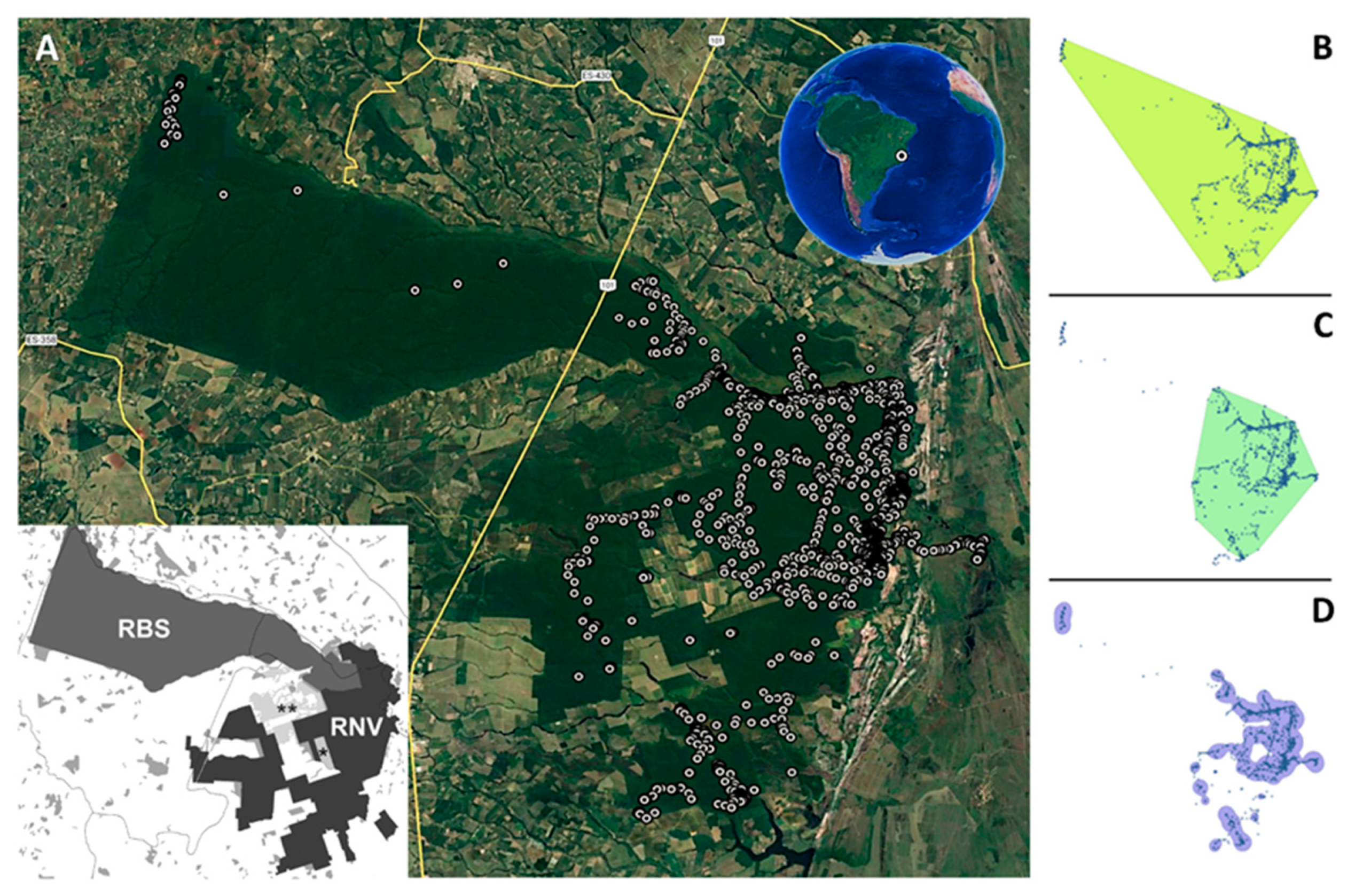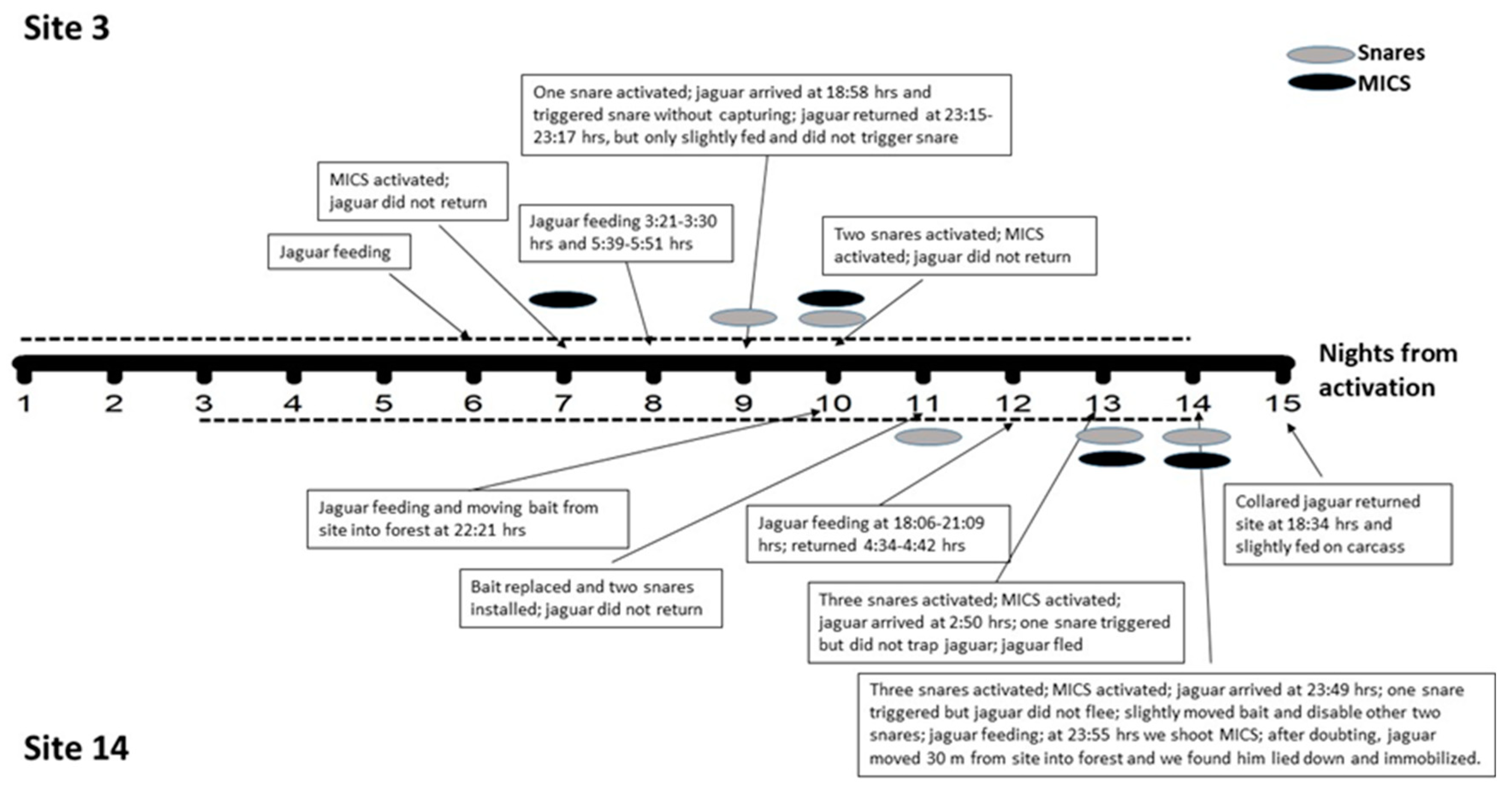First Capture of a Jaguar Using a Minimally Invasive Capture System for GPS Tracking in an Isolated Patch of Atlantic Forest in Southern Brazil
Abstract
:Simple Summary
Abstract
1. Introduction
2. Materials and Methods
2.1. Study Area
2.2. Trapping Procedures
2.3. Felid Immobilization and Collaring
2.4. Data Analysis
3. Results
3.1. Trapping Campaign 2018
3.2. Trapping Campaign 2019
3.3. Jaguar Characteristics and GPS Tracking
4. Discussion
Supplementary Materials
Author Contributions
Funding
Institutional Review Board Statement
Informed Consent Statement
Data Availability Statement
Acknowledgments
Conflicts of Interest
References
- Ray, J.; Redford, K.H.; Steneck, R. Large Carnivores and the Conservation of Biodiversity; Island Press: Washington, DC, USA, 2005. [Google Scholar]
- Roemer, G.W.; Gompper, M.E.; Van Valkenburgh, B. The ecological role of the mammalian mesocarnivore. BioScience 2009, 59, 165–173. [Google Scholar] [CrossRef]
- Estes, J.A.; Terborgh, J.; Brashares, J.S.; Power, M.E.; Berger, J.; Bond, W.J.; Carpenter, S.R.; Essington, T.E.; Holt, R.D.; Jackson, J.B.C.; et al. Trophic downgrading of planet Earth. Science 2011, 333, 301–306. [Google Scholar] [CrossRef] [PubMed]
- Morrison, J.C.; Sechrest, W.; Dinerstein, E.; Wilcove, D.S.; Lamoreux, J.F. Persistence of large mammal faunas as indicators of global human impacts. J. Mammal. 2007, 88, 1363–1380. [Google Scholar] [CrossRef]
- Wolf, C.; Ripple, W.J. Range contractions of the world’s large carnivores. R. Soc. Open Sci. 2017, 4, 170052. [Google Scholar] [CrossRef] [PubMed]
- Logan, K.A.; Sweanor, L.L.; Smith, J.F.; Hornocker, M.G. Capturing pumas with foot-hold snares. Wildl. Soc. Bull. 1999, 27, 201–208. [Google Scholar]
- Shury, T. Capture and Physical restraint of zoo and wild animals. In Zoo Animal and Wildlife Immobilization and Anesthesia; West, G., Heard, D., Caulkett, N., Eds.; Blackwell Publishing: Ames, IA, USA, 2007; pp. 131–144. [Google Scholar]
- Fraser, D.; MacRae, A.M. Four types of activities that affect animals: Implications for animal welfare science and animal ethics philosophy. Anim. Welf. 2011, 20, 581–590. [Google Scholar] [CrossRef]
- MacCarthy, J.L.; Belant, J.L.; Breitenmoser-Würsten, C.; Hearn, A.J.; Ross, J. Live trapping carnivores in tropical forests: Tools and techniques to maximize efficacy. Raffles Bull. Zool. 2013, 28, 55–66. [Google Scholar]
- Palomares, F. A minimally invasive capture system for the safe and compassionate live-trapping of jaguar and puma. Galemys 2018, 30, 49–59. [Google Scholar] [CrossRef]
- Schaller, G.B.; Crawshaw, P.G., Jr. Movement patterns of jaguar. Biotropica 1980, 12, 161–168. [Google Scholar] [CrossRef]
- Araujo, G.R.; de Deco-Souza, T.; Morato, R.G.; Crawshaw, P.G., Jr.; Cruz da Silva, L.; Jorge-Neto, P.N.; Csermak-Jr, A.C.; Bergo, L.C.F.; Zanella Kantek, D.L.; Miyazaki, S.S.; et al. Use of foot snares to capture large felids. Methods Ecol. Evol. 2020, 12, 322–327. [Google Scholar] [CrossRef]
- Ryser, A.; Scholl, M.; Zwahlen, M.; Oetliker, M.; Ryser-Degiorgis, M.P.; Breitenmoser, U. A remote-controlled teleinjection system for the low-stress capture of large mammals. Wildl. Soc. Bull. 2005, 33, 721–730. [Google Scholar] [CrossRef]
- Srbek-Araujo, A.C.; Haag, T.; Chiarello, A.G.; Salzano, F.M.; Eizirik, E. Worrisome isolation: Noninvasive genetic analyses shed light on the critical status of a remnant jaguar population. J. Mammal. 2018, 99, 397–407. [Google Scholar] [CrossRef]
- Paviolo, A.; De Angelo, C.; Ferraz, K.M.; Morato, R.G.; Martinez Pardo, J.; Srbek-Araujo, A.C.; Beisiegel, B.D.M.; Lima, F.; Sana, D.; Xavier da Silva, M.; et al. A biodiversity hotspot losing its top predator: The challenge of jaguar conservation in the Atlantic Forest of South America. Sci. Rep. 2016, 6, 37147. [Google Scholar] [CrossRef]
- FSOSMA. INPE (Fundação SOS Mata Atlântica, Instituto Nacional de Pesquisas Espaciais) Atlas dos Remanescentes Florestais da Mata Atlântica—Período 2019–2020. 2021, São Paulo. Available online: https://cms.sosma.org.br/wp-content/uploads/2021/05/SOSMA_Atlas-da-Mata-Atlantica_2019-2020.pdf (accessed on 15 May 2022).
- Srbek-Araujo, A.C.; Mendes, S.L.; Chiarello, A.G. Jaguar (Panthera onca Linnaeus, 1758) roadkill in Brazilian Atlantic Forest and implications for species conservation. Braz. J. Biol. 2015, 75, 581–586. [Google Scholar] [CrossRef] [PubMed]
- Jesus, R.M.; Rolim, S.G. Fitossociologia da Floresta Atlântica de Tabuleiro. Bol. Técnico Soc. Investig. Florestais 2005, 19, 1–150. [Google Scholar]
- Kierulff, M.C.M.; Avelar, L.H.S.; Ferreira, M.E.S.; Povoa, K.F.; Bérnils, R.S. Reserva Natural Vale: História e aspectos físicos. Ciência Ambiente 2014, 49, 7–40. [Google Scholar]
- Steiniger, S.; Hunter, A.J.S. A User Manual to perform Home Range Analysis and Estimation with OpenJUMP HoRAE. 2013. Available online: https://docplayer.net/37128574-A-user-manual-to-perform-home-range-analysis-and-estimation-with-openjump-horae.html (accessed on 12 January 2021).
- Srbek-Araujo, A.C.; Chiarello, A.G. Population status of the jaguar Panthera onca in one of its last strongholds in the Atlantic Forest. Oryx 2017, 51, 246–253. [Google Scholar] [CrossRef]
- Calvacanti, S.M.C. Predator-Prey Relationships and Spatial Ecology of Jaguars in the Southern Pantanal, Brazil: Implications for Conservation and Management. Ph.D. Thesis, Utah State University, Logan, UT, USA, 2008. [Google Scholar]
- Phillips, K.A.; Elvey, C.R.; Abercrombie, C.L. Applying GPS to the study of primate ecology: A useful tool? Am. J. Primatol. 1998, 46, 167–172. [Google Scholar] [CrossRef]
- Camp, M.J.; Rachlow, J.L.; Cisneros, R.; Roon, D.; Camp, R.J. Evaluation of Global Positioning System telemetry collar performance in the tropical Andes of southern Ecuador. Nat. Conserv. 2016, 14, 128–131. [Google Scholar] [CrossRef]
- Morato, R.G.; Stabach, J.A.; Fleming, C.H.; Calabrese, J.M.; De Paula, R.C.; Ferraz, K.M.P.M.; Kantek, D.L.; Miyazaki, S.S.; Pereira, T.D.; Araujo, G.R.; et al. Space Use and Movement of a Neotropical Top Predator: The Endangered Jaguar. PLoS ONE 2016, 11, e0168176. [Google Scholar] [CrossRef]
- Gonzalez-Borrajo, N.; López-Bao, J.V.; Palomares, F. Spatial ecology of jaguars, pumas, and ocelots: A review of the state of knowledge. Mammal Res. 2017, 47, 62–75. [Google Scholar] [CrossRef]
- Morato, R.G.; Connette, G.M.; Stabach, J.A.; Paula, R.C.; Ferraz, K.M.P.M.; Kantek, D.L.Z.; Miyazaki, S.S.; Pereira, T.D.C.; Silva, L.C.; Paviolo, A.; et al. Resource selection in an apex predator and variation in response to local landscape characteristics. Biol. Conserv. 2018, 228, 233–240. [Google Scholar] [CrossRef]
- Entringer, H., Jr.; Del Duque, H.J., Jr.; Chiarello, A.G.; Srbek-Araujo, A.C. Temporal variation of the diet of a top terrestrial predator: The jaguar as a case study. Mammal Res. 2022, 67, 417–431. [Google Scholar] [CrossRef]


| Vegetation or Land Use Type | Protected Reserves | % | Outside Reserves | % | Total | % |
|---|---|---|---|---|---|---|
| Native grassland | 1295 | 28.9 | 10 | 3.2 | 1305 | 27.2 |
| Mussununga forest | 245 | 5.5 | 79 | 25.5 | 324 | 6.8 |
| Dense lowland forest | 1157 | 25.8 | 29 | 9.4 | 1186 | 24.7 |
| Riparian vegetation | 731 | 16.3 | 50 | 16.1 | 781 | 16.3 |
| Marsh | 1060 | 23.6 | 132 | 42.6 | 1192 | 24.8 |
| Firebreak | - | - | 7 | 2.3 | 7 | 0.2 |
| Forestry | - | - | 3 | 0.9 | 3 | 0.1 |
| Total | 4488 | 93.5 | 310 | 6.5 | 4798 | - |
Disclaimer/Publisher’s Note: The statements, opinions and data contained in all publications are solely those of the individual author(s) and contributor(s) and not of MDPI and/or the editor(s). MDPI and/or the editor(s) disclaim responsibility for any injury to people or property resulting from any ideas, methods, instructions or products referred to in the content. |
© 2023 by the authors. Licensee MDPI, Basel, Switzerland. This article is an open access article distributed under the terms and conditions of the Creative Commons Attribution (CC BY) license (https://creativecommons.org/licenses/by/4.0/).
Share and Cite
Palomares, F.; de Paula, T.A.R.; Srbek-Araujo, A.C. First Capture of a Jaguar Using a Minimally Invasive Capture System for GPS Tracking in an Isolated Patch of Atlantic Forest in Southern Brazil. Animals 2023, 13, 3314. https://doi.org/10.3390/ani13213314
Palomares F, de Paula TAR, Srbek-Araujo AC. First Capture of a Jaguar Using a Minimally Invasive Capture System for GPS Tracking in an Isolated Patch of Atlantic Forest in Southern Brazil. Animals. 2023; 13(21):3314. https://doi.org/10.3390/ani13213314
Chicago/Turabian StylePalomares, Francisco, Tarcízio Antônio Rego de Paula, and Ana Carolina Srbek-Araujo. 2023. "First Capture of a Jaguar Using a Minimally Invasive Capture System for GPS Tracking in an Isolated Patch of Atlantic Forest in Southern Brazil" Animals 13, no. 21: 3314. https://doi.org/10.3390/ani13213314
APA StylePalomares, F., de Paula, T. A. R., & Srbek-Araujo, A. C. (2023). First Capture of a Jaguar Using a Minimally Invasive Capture System for GPS Tracking in an Isolated Patch of Atlantic Forest in Southern Brazil. Animals, 13(21), 3314. https://doi.org/10.3390/ani13213314





